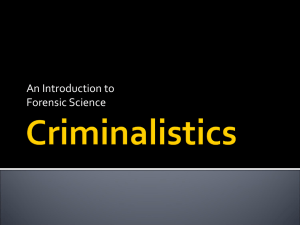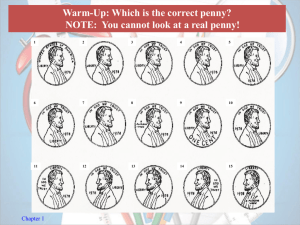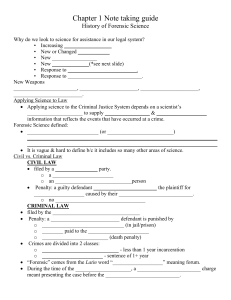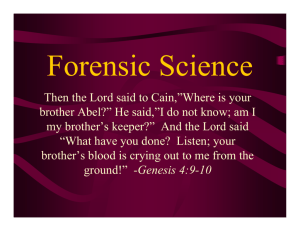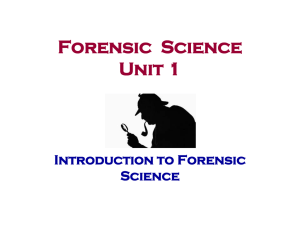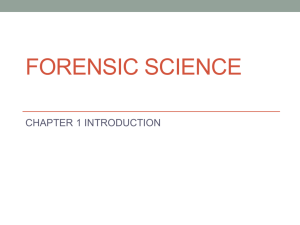History & Development of Forensic Science
advertisement
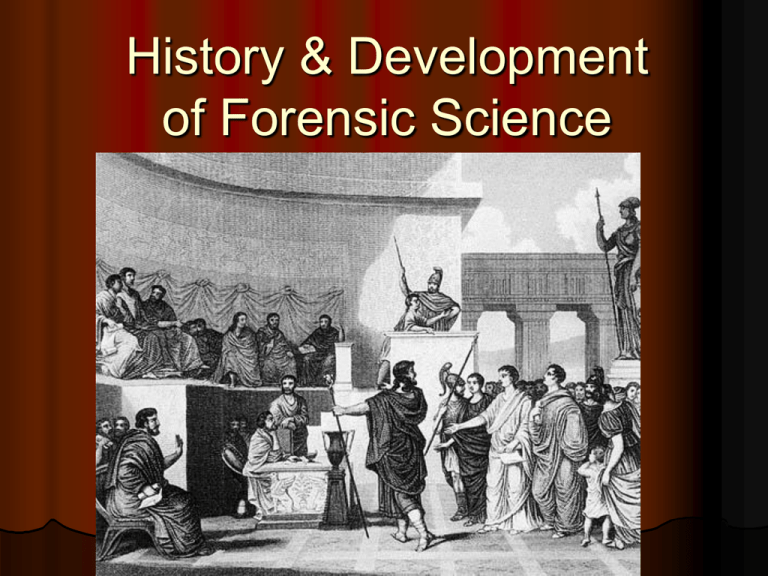
History & Development of Forensic Science History and Development of Forensic Science The word “forensic” is derived from the Latin word, forensis, meaning forum, a public place where, in Roman times, senators and others debated and held judicial proceedings. Both the person accused of the crime & the accuser would give speeches based on their side of the story. The individual with the best argument would determine the outcome of the case. Forensic Science (Criminalistics) Forensic science is the application of science to the criminal and civil laws that are enforced by police agencies in a criminal justice system. Saferstein, Richard. Forensic Science An Introduction. Second edition. Civil vs. Criminal Law CIVIL LAW CRIMINAL LAW filed by a private party. o a corporation o an individual person filed by the government Penalty: a guilty defendant is punished by Penalty: a guilty defendant o incarceration (in jail/prison) pays the plaintiff for losses o fine paid to the gov’t caused by their actions. o execution (death penalty) o no incarceration Crimes are divided into 2 classes: o misdemeanors - less than 1 year incarceration o felonies - sentence of 1+ year Some sciences involved in forensics are…… Chemistry Biology Physics Geology Botany Anthropology Physiology …….Just to name a few! Contributions to the Field of Forensic Science Mathieu Orfila (1787-1853) “Father of Toxicology” Wrote about the detection of poisons & their effects on animals. Alphonse Bertillon (1853-1914) “Father of Anthropometry” Developed a system to distinguish one individual person from another based on certain body measurements. A N T H R O P O M E T R Y Francis Galton (1822-1911) “Father of Fingerprinting” Provided statistical proof supporting fingerprinting as a way to uniquely identify individuals. Karl Landsteiner (1868-1943) “Father of Blood Typing” He discovered that blood can be grouped into different categories. Blood types (A, B, AB, or O) can narrow the list of possible suspects. Sir Arthur Conan Doyle Sci-fi author in late 1800’s—created legendary detective, ‘Sherlock Holmes’ Applied many of the principles of modern forensic science long before their value was recognized and accepted by real-life criminal investigators. Albert Osborn (1858-1946) “Father of Document Examination” His work led to the acceptance of documents as scientific evidence by the courts. Calvin Goddard (1891-1955) “Father of Ballistics” Developed the technique to examine bullets, using a comparison microscope, to determine whether or not a particular gun fired the bullets. Edmond Locard (1877-1966) “Father of the Crime Lab” In 1910, he started the 1st crime lab in an attic of a police station. With few tools, he quickly became known world-wide to forensic scientists & criminal investigators & eventually founded the Institute of Criminalistics in France. His most important contribution was “Locard’s Exchange Principle” Locard’s Exchange Principle When two objects come into contact with each other, a cross-transfer of materials occurs. “Every Contact Leaves a Trace.” He believed that every criminal can be connected to a crime by particles carried from the crime scene. Alec Jeffreys (1950- ) “Father of DNA Fingerprinting” Developed a technique that allows investigators to match biological samples left at a crime scene to a suspect.




